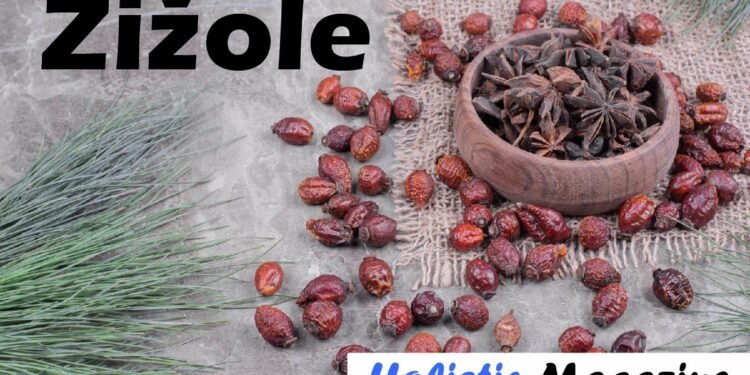Žižole is a remarkable fruit that comes from the Ziziphus jujuba tree, a member of the Rhamnaceae family. Often referred to as jujube, Chinese date, red date, or Mediterranean jujube, žižole has been cherished across cultures for both its nutritional richness and traditional healing power. The fruit itself begins as a small, green, apple-like sphere with smooth, taut skin. As it ripens, žižole gradually turns a reddish-brown hue, becoming sweeter and softer. When dried, the skin wrinkles, and the inside becomes chewy—quite similar to a date.
This dual identity of being crisp and fresh when young and sweet and dense when dried is what makes žižole unique. Not only are they consumed as food, but in many cultures, žižole are revered for their health-supporting properties, often brewed into teas or used in natural remedies. Within the first few bites, one can taste both nature’s sweetness and a long legacy of use. Whether you know it by its botanical name or its local nickname, žižole is much more than a fruit—it’s a cultural treasure wrapped in nutrition and flavor.
The Origins and History of Žižole
Ancient Beginnings in China
The historical journey of žižole begins over 4,000 years ago in China, where it was first cultivated for its flavor and medicinal uses. In traditional Chinese medicine, žižole is considered a vital food for calming the spirit, nourishing the blood, and aiding digestion. It was commonly used in herbal formulas to support better sleep, restore energy, and protect the heart. Farmers and herbalists revered žižole not just as a fruit but as a healing companion that supported daily life. Symbolically, the fruit came to represent peace, vitality, and harmony. Ancient Chinese texts describe its importance in royal gardens and apothecaries alike, illustrating its dual use as both sustenance and remedy.
Journey Along Trade Routes
As trade routes like the Silk Road opened, žižole made its way from China into Persia, India, and the broader Middle East. Along the way, it embedded itself in the healing practices of Ayurveda and Unani medicine, becoming a staple for promoting energy and emotional balance. Persian herbalists would dry žižole and mix them with rose petals and spices to form invigorating teas. In India, they were often used to soothe digestive discomfort and promote inner calm. The adaptability of žižole made it easy to grow in various climates, which contributed to its spread. Traders carried it not just as a food source but as a valuable crop that symbolized vitality and longevity.
Arrival in the Mediterranean
Eventually, žižole reached Southern Europe—particularly Dalmatia, Southern Italy, and Slovenia—where it found a perfect home in coastal gardens and rural landscapes. Mediterranean communities quickly adopted the fruit, integrating it into folk remedies and seasonal customs. In villages, families would gather in the autumn to pick fresh žižole, dry them under the sun, or boil them into syrups.
Local healers recommended žižole for winter wellness, while elders spoke of its calming nature. The tree’s resilience and beauty made it a popular addition to home gardens, while the fruit became a favorite among children and adults alike. Over time, žižole became not only a fruit but also a nostalgic symbol of tradition, simplicity, and seasonal joy.
How Žižole Grow and What They Look Like
The Ziziphus jujuba tree is an exceptionally hardy plant, well-suited to dry, sunny climates with poor soil. It typically reaches a height of 4 to 10 meters and features gnarled, thorny branches with small, shiny oval leaves. These leaves glimmer in the sunlight, creating a distinctive shimmer in orchards. In late spring, tiny yellowish-green flowers appear, unassuming yet vital for fruit production. By summer’s end, these blossoms transform into the familiar fruit—first green, then slowly transitioning to golden brown and finally deep red as they ripen.
The fruit’s shape varies from round to slightly oval and its skin remains smooth until the drying process begins. Dried žižole are easily recognizable by their wrinkled skin, chewy interior, and rich mahogany color. These trees are not only long-lived but also environmentally resilient, often thriving in marginal land with minimal irrigation. Their lifespan can exceed 100 years, making them a valuable asset in sustainable farming and long-term horticulture.
Nutritional Power of Žižole
Žižole are nutritional dynamos, packed with vitamin C, dietary fiber, potassium, and iron, all of which contribute to their status as a powerful functional food. They contain antioxidants like flavonoids, saponins, and polysaccharides, which help neutralize free radicals and support immune health. Fresh žižole contain more vitamin C and are lower in natural sugar compared to their dried counterparts, making them a perfect guilt-free snack.
Dried žižole, while higher in sugar, offer concentrated sources of minerals and phytochemicals, making them ideal for use in tonics and energy snacks. Unlike many fruits, žižole offer both quick energy from natural sugars and long-term support through slow-digesting fiber. They are low in calories, yet rich in benefits, appealing to health-conscious eaters seeking balance and taste in one bite.
Health Benefits of Žižole
Sleep and Relaxation
One of the most well-known traditional uses of žižole is for improving sleep. The fruit contains compounds that help calm the nervous system, making it a common ingredient in herbal teas meant to reduce stress and promote restful sleep. Scientific research supports this, showing that jujube extracts may influence neurotransmitters associated with sleep regulation. Many cultures brew žižole with chamomile or licorice root to create relaxing bedtime drinks. These properties make žižole a gentle, non-pharmaceutical option for those struggling with insomnia or anxiety.
Immune System Support
Žižole are loaded with vitamin C, one of the most important nutrients for strengthening the immune system. Alongside this, their antioxidant-rich profile helps reduce inflammation and oxidative stress, which are key factors in many chronic illnesses. During seasonal transitions or stressful periods, consuming žižole can help keep the immune defenses sharp and responsive. Whether eaten fresh, dried, or steeped in tea, it offer support that is both delicious and dependable.
Gut Health and Digestion
Thanks to their high fiber content, it support a healthy digestive system by promoting regular bowel movements and improving gut flora balance. The soluble fiber found in these fruits acts as a prebiotic, feeding beneficial gut bacteria and enhancing nutrient absorption. People with sluggish digestion or bloating may find relief from regularly consuming it, especially when combined with a whole-food diet rich in vegetables and grains.
Anti-inflammatory and Anti-aging Potential
Flavonoids in It contribute to their anti-inflammatory properties, helping to reduce the cellular damage caused by stress, pollution, or aging. These compounds also play a role in supporting skin health, collagen production, and overall vitality. For those seeking to age gracefully and maintain skin elasticity, žižole can serve as a valuable part of their dietary skincare routine.
Cultural and Traditional Uses of Žižole
In Eastern Traditions
In China, It are considered a warming food that harmonizes the body and mind. At Korea, they are used in traditional sweets and medicinal broths. In Persian culture, dried it often appear in mixtures meant to soothe sore throats or revive energy during fasting. Their inclusion in family medicine cabinets and community recipes reflects deep trust in their benefits.
In the Balkans and Mediterranean
Families in Croatia, Slovenia, and Southern Italy treat žižole as symbols of abundance and seasonal rhythm. Autumn gatherings often involve communal fruit picking, drying, and preserving. Grandparents pass down recipes for it syrup or brandy, linking generations through taste and tradition. Local markets often highlight these fruits as prized autumnal offerings.
Spiritual Symbolism
In many cultures,It are believed to offer protection and spiritual comfort. Some hang dried žižole near doorways to ward off negative energy. Others use the fruit in ceremonial teas or offerings during religious observances. The calming essence of žižole has made it a staple in both spiritual and domestic spaces.
Culinary Uses Around the World
Eating Fresh and Dried
Fresh žižole provide a crisp, refreshing taste ideal for snacking. Dried versions are sweeter and resemble dates, making them perfect for energy bites and desserts.
Infusions and Teas
It teas are made by simmering the dried fruit with ginger, cinnamon, or goji berries. These infusions are often consumed at night for relaxation or during illness for immune support.
Traditional Sweets and Preserves
In the Mediterranean, it are boiled with sugar to create syrups or marmalades. They are also steeped into fruit brandies known as rakija. In Asia, they’re baked into rice cakes or used to sweeten broths.
Modern Recipes and Trends
Today, chefs add žižole to grain bowls, salads, smoothies, and health bars. Their natural sweetness makes them a great sugar substitute in plant-based snacks.
Žižole and Modern Wellness Culture
With wellness trends focusing on natural remedies and low-GI foods, žižole have resurfaced as a sought-after superfruit. Nutritionists recommend them for balanced snacking, while herbalists endorse their calming effects. Athletes and vegans appreciate the mineral-rich profile, especially when trying to reduce processed sugar. it fit perfectly into adaptogenic, immunity-boosting, and ancestral health diets. Their low environmental footprint adds to their appeal among eco-conscious shoppers and sustainable brands.
Growing and Harvesting Žižole
Where They Grow Today
It trees flourish in countries like China, India, Iran, and throughout the Mediterranean. They adapt well to semi-arid environments, making them suitable for future farming.
Home Gardening Potential
These trees are great for home gardens in sunny, warm climates. They require minimal water and are resistant to pests.
Harvesting and Storage Tips
The best time to harvest is late summer or early fall. Fresh it should be stored in the fridge, while dried ones can be kept in sealed containers for months.
Sustainability and Agricultural Benefits
It trees thrive in poor soil, require little irrigation, and are naturally resistant to pests. This makes them a top candidate for sustainable farming, especially in areas affected by climate change. Their low resource needs and long lifespan make them excellent for agroforestry and regenerative practices.
Myths and Symbolic Meaning of Žižole
Across ancient cultures, žižole symbolized tranquility, fertility, and safety. Some believed placing them under pillows brought peaceful dreams. In folktales, the fruit often represented protection, endurance, or reward. While science may not verify all myths, these stories highlight the emotional significance of žižole in human history.
Žižole Compared to Other Fruits
| Trait | Žižole | Apple | Date |
|---|---|---|---|
| Texture (fresh) | Crisp | Crisp | Soft |
| Texture (dried) | Chewy | Spongy | Chewy |
| Sweetness level | Mild to strong | Mild | Very sweet |
| Uses | Snacks, teas, jams | Snacks, juice | Desserts, energy |
| Nutritional focus | Vitamin C, iron | Fiber, antioxidants | Sugar, minerals |
Where to Buy and How to Use Žižole
It are available at Asian groceries, farmers markets, herbal stores, or online platforms. When buying, look for unprocessed, organic dried fruit. Store fresh žižole in the fridge for a week. Dried ones can last several months in a cool, dry pantry. Serve sliced to children or add to elder-friendly meals for extra nutrients.
Safety, Allergies, and Precautions
It are safe for most people. Overeating may cause bloating due to fiber. For young children, slice dried žižole to prevent choking. No major allergies have been reported. Always introduce new foods gradually and consult healthcare providers if unsure.
Future of Žižole in Food and Medicine
Researchers are exploring žižole’s use in stress management, immunity, and anti-aging. With its adaptability, the fruit is also gaining interest as a climate-resilient superfood. Western markets are beginning to embrace žižole in supplements, herbal teas, and gourmet snacks, signaling a bright future for this ancient treasure.
Conclusion: Why Žižole Deserve a Place in Your Life
Žižole are more than just a fruit—they are a bridge between history, wellness, and sustainability. Their ability to nourish, calm, and connect us to tradition makes them truly special. Whether enjoyed as a snack, remedy, or ingredient, it can enrich modern life while honoring ancient wisdom. Embrace it in your kitchen, garden, or wellness routine, and taste the legacy of a timeless treasure.
FAQs About Žižole
What does “žižole” mean?
Žižole is a regional term for jujube, a small red fruit used in food and medicine.
Are žižole good for sleep?
Yes, they have natural compounds that promote relaxation and deeper sleep.
Can kids eat žižole?
Absolutely—just slice or mash for toddlers to avoid choking.
Where can I buy žižole?
You’ll find them in Asian stores, farmers’ markets, or online herbal retailers.
How do I use žižole in recipes?
Add them to tea, oatmeal, smoothies, baked goods, or enjoy them fresh as snacks.
Also read :
Koriandri: Uses, Health, and Global Culinary Power
SkinPres T: Personalized Smart Skincare That Works Fast
Visit For More Info : Holistic Magazine


















Discussion about this post